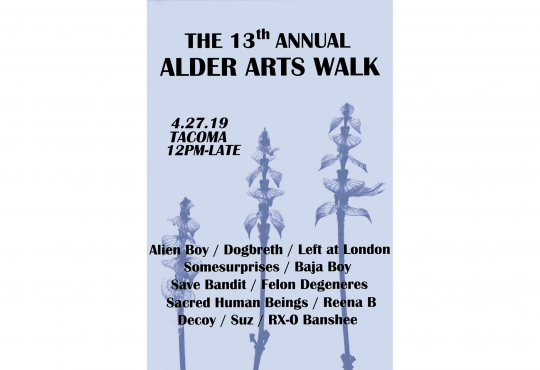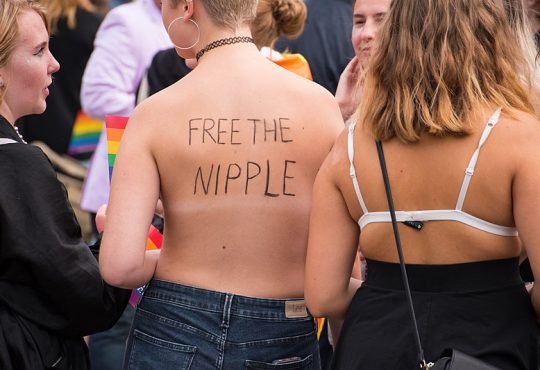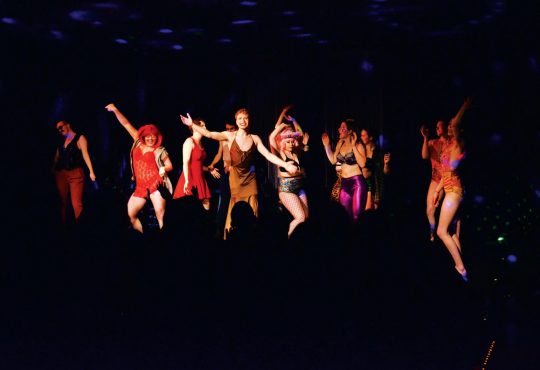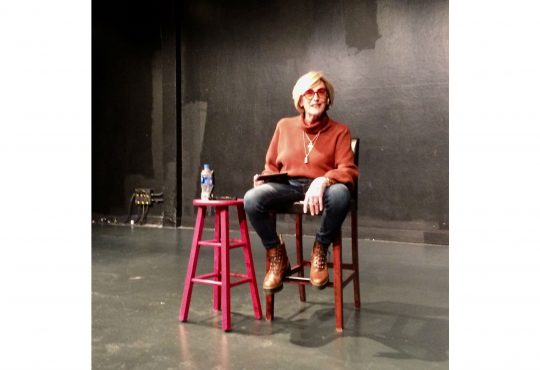It was another rainy, blustery night in Seattle, Washington. The wind was blowing especially hard, and what better place to find refuge than in an explosive, inclusive art show that could morph into a dance party?
Held by Lion’s Main Art Collective, last November’s “Erasure” event was a huge and unique success. That night the Nuclear Exchange Studio and VCR gallery was turned into a vibrant space full of interdisciplinary art. There were both two and three dimensional visual pieces, performance art, video, music and dance. The variety of mediums felt appropriate, given that the purpose of the event was to create an all-inclusive space for over 30 queer artists to explore the theme of erasure, and express that theme as freely as they could, in any way they could.
“It could be personal identity erasure, or body erasure… to racial erasure. Really any kind you could think of was well-represented,” Lion’s Main publicist and University of Puget Sound alum Olivia Green said. Attendees were immersed in visual art, from magical realism paintings of houses exploding with flowers, to artist Marianne Carter’s heart-shaped balloons hanging from the ceiling, donning silk blue underwear daintily embroidered with the hilarious, but biting question: “Straight boys, why are you still here?”
This piece is emblematic of the shows combination of abrasion and light, hard messages and raw feelings expressed in joyous celebratory ways.
“We do not claim to be a safe space,” fundraising coordinator and fellow University alum Jackie Braun said of Lion’s Main. “We value transparency… we have all these strangers coming together and they all have histories that we have no control over.” They understand the balance between freedom, safety and necessity, and when dealing with subjects both vital and sensitive such as trauma and family dynamics within some queer lives, they try their best.
Some personal favorites of attendee and University of Puget Sound student Kaylee Faber’s were a “No Dads” poem accompanied by “kitschy grandma house stuff” for femme-only families, and a performance artist turning the songs of their Dad’s beloved heteronormative John Mellencamp into hilarious and endearing queer parodies. All of the works intertwined the political and the personal, in an attempt to find some sort of catharsis in these small actions. A video of someone beaming with joy after shaving their head shows how much small, symbolic acts of self expression can do. Braun and Green both felt that the night simply needed to happen; there was a sense of urgency to it. Artist Yani Robinson’s performance piece on breaking through stigmas and feelings about being a survivor even breached some physical limits for the space.
“It involved fire and there were tears,” Green said.
This night had been a pinnacle for the Lion’s Main Art Collective, and served as a great way to connect the group to the outer community. At the moment, Lion’s Main is a group of artists that meet weekly to share their work and ideas, and also showcase interdisciplinary art whenever they can. Though people from absolutely all backgrounds are welcome to join, there is a focus on the inclusion and representation of marginalized groups, especially those within the queer community.
Over the past couple of years, Braun and Green have seen the culture surrounding their work move away from masculine-centric interests, become more femme-inclusive and more intersectional in general. As queer art becomes more visible, the two have made more of an effort to create not only queer spaces but spaces with racial safety and accessibility for people with disabilities. The collective has also been providing skill-share classes, or “work courses” in order to put as many skills out into the world as possible, from web design classes to workshops on tailoring, figure drawing and even DIY rope making. They will also be having a summer art show in a park in south Seattle, among other upcoming events.
Especially given the dislocation Seattle gentrification has caused in the queer art community, Green and Braun recognize the importance of expanding the reach of their collective beyond Capitol Hill. More events will be moving south, and hopefully more outlets for marginalized voices will open. Faber felt the necessity of opportunities such as the Erasure event, noting that the representation of diverse voices contrasted even the art she sees exhibited on campus.
For anyone who has ever experienced being in a place that doesn’t provide for them, art and the art community can feel like home. Green especially felt that, after returning here from New York, the art community that once started at the University had grown into a family for her, and she had seen that happen to many others too.
“I think art is important in all communities, but especially in ones that are often told how to be or what to be, [you can] express feelings that you weren’t even sure were in you in the first place,” she said. People may experience erasure in almost any kind of public space, but art can always be that last refuge of release, joy, and maybe even change. “Erasure is a problem and we’re working on it,” said Braun, “But at least we can get together and dance and create beautiful things about it.”
You can keep up with Lion’s Main’s endeavors and other related events (such as the Lush Us arts showcase) on the Lion’s Main Art Collective Facebook page and @lionsmainart on Twitter. If you are interested in their weekly art meetings, on Tuesdays at 8pm, contact them via their Facebook page. All are welcome.





